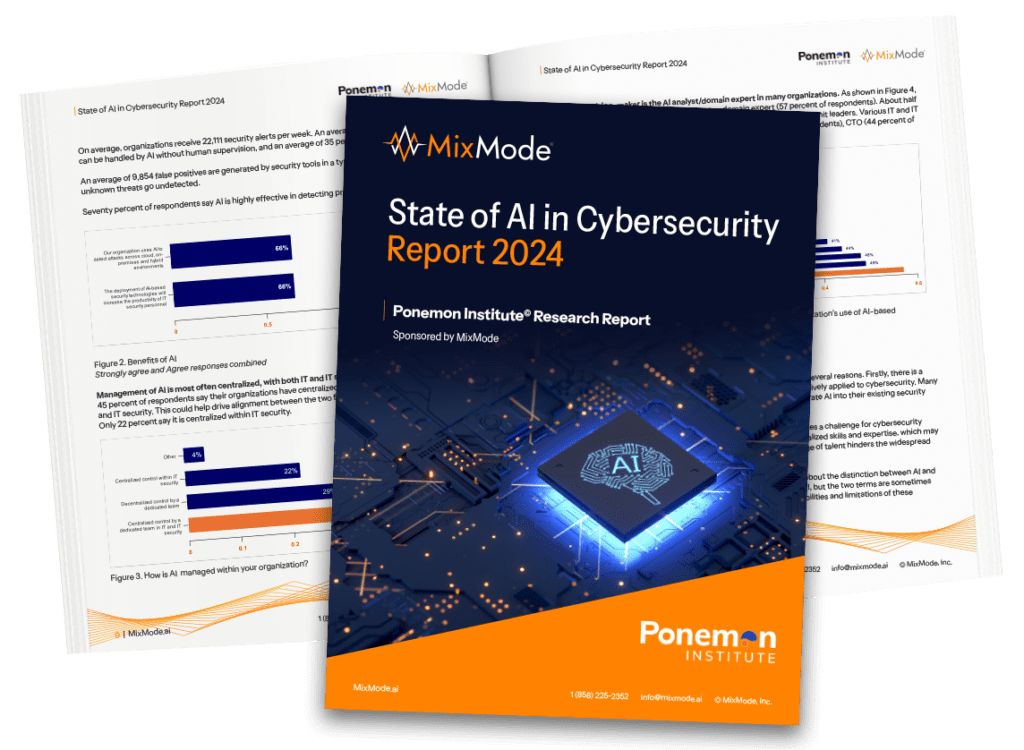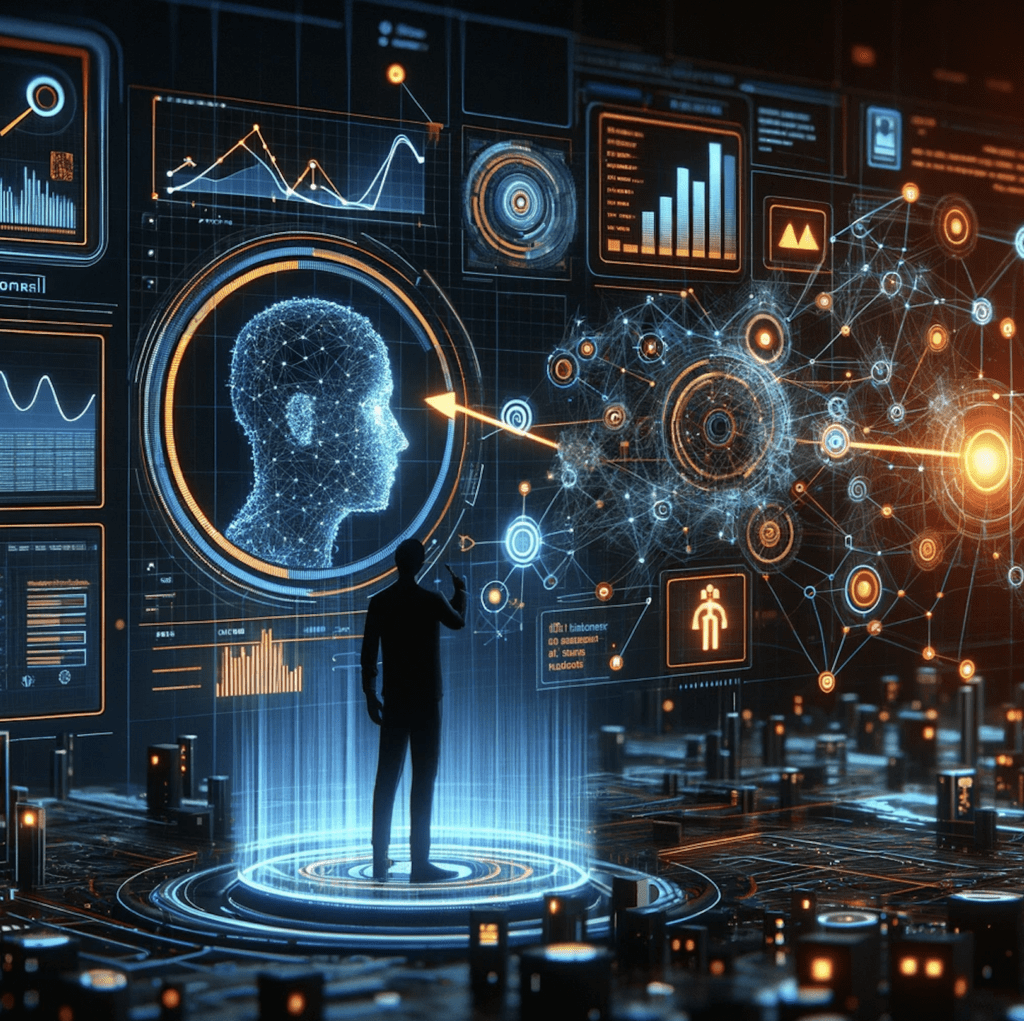Unveiling the Power: A Strategic Look at the Benefits of Using AI in Cybersecurity

Download the Report
If you’ve followed this blog series, you already know that Artificial intelligence (AI) has become a ubiquitous term, holding immense promise across various industries. Cybersecurity is no exception, with AI poised to revolutionize how organizations defend their data and systems against malicious activity. However, a crucial question remains: Are cybersecurity teams effectively harnessing AI’s potential for maximum security impact?
MixMode’s State of AI in Cybersecurity Report 2024 explored the current usage of artificial intelligence in cybersecurity and its potential impact on organizations, highlighting its benefits and the challenges organizations face in maximizing its value.
The Allure of AI: Unveiling its Advantages in Cybersecurity
There’s no denying the potential of artificial intelligence to transform cybersecurity. Some of the key benefits it brings to the table include:
- Enhanced Threat Detection: Legacy security solutions often rely on predefined rules, leaving them vulnerable to novel attacks and unknown threats. AI can identify subtle anomalies and patterns in network traffic, user activity, and endpoint devices through its superior data analysis capabilities. This allows for real-time threat detection of even the most sophisticated cyber attacks that might bypass traditional methods.
- Automated Incident Response: Security teams are constantly inundated with alerts, making it challenging to prioritize and respond effectively. AI can automate repetitive tasks such as log analysis and incident investigation, freeing valuable human resources to focus on complex threat assessments and strategic decision-making. Additionally, AI can trigger pre-defined automated response actions in the event of a security breach, such as isolating infected systems or blocking malicious traffic. This significantly reduces the window of opportunity for attackers and minimizes potential damage.
- Improved Threat Analysis and Prioritization: The sheer volume of data generated in today’s digital landscape can overwhelm security analysts. AI can analyze historical security incidents and threat intelligence feeds to identify trends and predict future attacks. This allows security teams to prioritize threats based on potential severity and allocate resources more effectively, focusing on the most critical vulnerabilities.
- Security Automation: AI can automate various routine security tasks, including vulnerability scanning, patch management, and user access control. This reduces the workload for security personnel and ensures consistency and accuracy in these critical processes, mitigating the risk of human error.

The Gap Between Potential and Reality: Challenges in Implementing AI for Security
While the benefits of AI in cybersecurity are undeniable, MixMode’s State of AI in Cybersecurity Report 2024 found that organizations face challenges in realizing their full potential. Some key obstacles to consider include:
- Identifying the Right Use Cases: The sheer range of AI applications can be overwhelming. Organizations often need help to pinpoint exactly where AI can add the most value within their specific security infrastructure. According to the report, only 44% of respondents reported a high ability to identify these areas effectively. This highlights the need for a more strategic approach to AI adoption, focusing on areas with the highest potential return on investment and aligning AI implementation with overall security objectives.
- Data Quality and Bias: AI algorithms are only as good as the data they are trained on. Poor quality data, including inconsistencies or biases, can lead to inaccurate threat detection and ineffective security responses. Organizations must prioritize data quality initiatives to ensure their AI models are trained on clean, reliable information. Additionally, mitigating algorithmic bias is crucial to prevent AI from perpetuating existing inequalities or making discriminatory access control or security measures decisions.
- Integration Challenges: Integrating AI with existing security infrastructure can be complex. Organizations need to consider compatibility issues, data security concerns, and the potential for disruptions to ongoing security operations. A well-defined implementation plan that factors in these challenges is essential for a smooth and successful integration process.
- The Human Factor: AI is not a silver bullet. Human expertise remains crucial in interpreting AI insights, investigating potential threats, and making critical security decisions. Organizations must foster a culture of collaboration between security teams and AI, leveraging the strengths for optimal security posture.

The Road Ahead: Embracing the Future of AI-Powered Security
MixMode’s State of AI in Cybersecurity Report 2024 findings depict an evolving landscape. Progress has been made in AI adoption for cybersecurity, but challenges remain. By acknowledging these hurdles and taking proactive measures, organizations can unlock AI’s full potential and build a more robust defense against cyber threats.
Some key takeaways for organizations based on the research include:
- Develop a Strategic AI Roadmap: Conduct a thorough assessment of your security infrastructure to identify areas where AI can deliver the most significant impact. Align AI implementation with your overall security strategy and prioritize use cases with the highest potential return on investment.
- Invest in Data Quality: Data is the lifeblood of AI. Organizations must prioritize data governance initiatives to ensure the data used to train AI models is accurate, complete, and free from bias. Implementing data cleansing techniques, establishing data quality standards, and fostering a culture of data ownership within the organization are crucial steps in this process.
- Embrace Continuous Learning: AI is not a static tool. As the threat landscape evolves, so must your AI models to keep up with various attacks. Organizations should build mechanisms for continuous learning, allowing models to adapt to new threats and improve their performance over time. This may involve retraining models with fresh data sets or employing reinforcement learning techniques to enable the models to learn through trial and error in simulated environments.
- Prioritize Explainable AI (XAI): Transparency and trust are vital for successful AI adoption in security. Organizations should invest in explainable AI (XAI) solutions that provide security analysts with insights into how AI models arrive at their conclusions. This allows for better understanding and improved decision-making, fostering collaboration between humans and AI.
- Bridge the Skills Gap: Leveraging AI effectively requires a skilled workforce. Organizations must invest in training programs that equip security professionals with the necessary skills to work alongside AI. This may involve courses on data analysis, AI fundamentals, and understanding the limitations of AI in security applications.
- Foster a Culture of Collaboration: The human element remains irreplaceable in cybersecurity. Building a culture that encourages collaboration between security experts and AI is essential. Security analysts should see AI as a powerful tool to augment their capabilities rather than a replacement for their expertise.
The Need for Collaboration
The future of cybersecurity lies in the synergy between human intelligence and AI capabilities. As AI technologies are refined and the identified challenges addressed, AI will play an increasingly crucial role in safeguarding organizations from ever-evolving cyber threats. By adopting a strategic approach to AI implementation, organizations can unlock this potential and build a more resilient security posture, fostering a world where organizations can confidently operate in the digital landscape.
The future is not a world dominated by machines but rather a world where cybersecurity professionals and AI work together in a collaborative partnership. By harnessing the power of AI and combining it with human expertise, organizations can build a robust defense against security risks and create a more secure digital environment for everyone.
I hope you enjoyed reading this series as much as I enjoyed writing it. But, if you’re new and haven’t already, download MixMode’s State of AI in Cybersecurity Report. Then, reach out to learn how MixMode can help your organization benefit from advanced artificial intelligence.


.png)